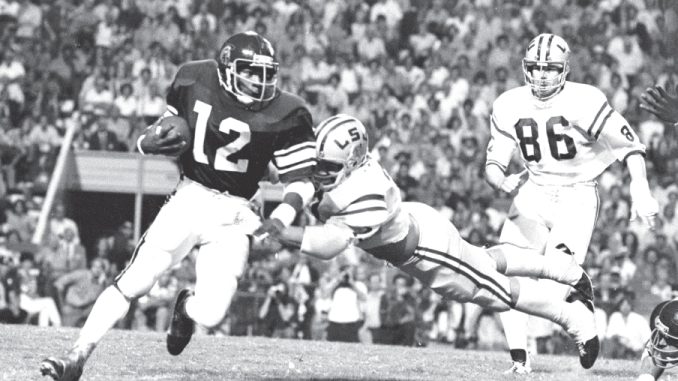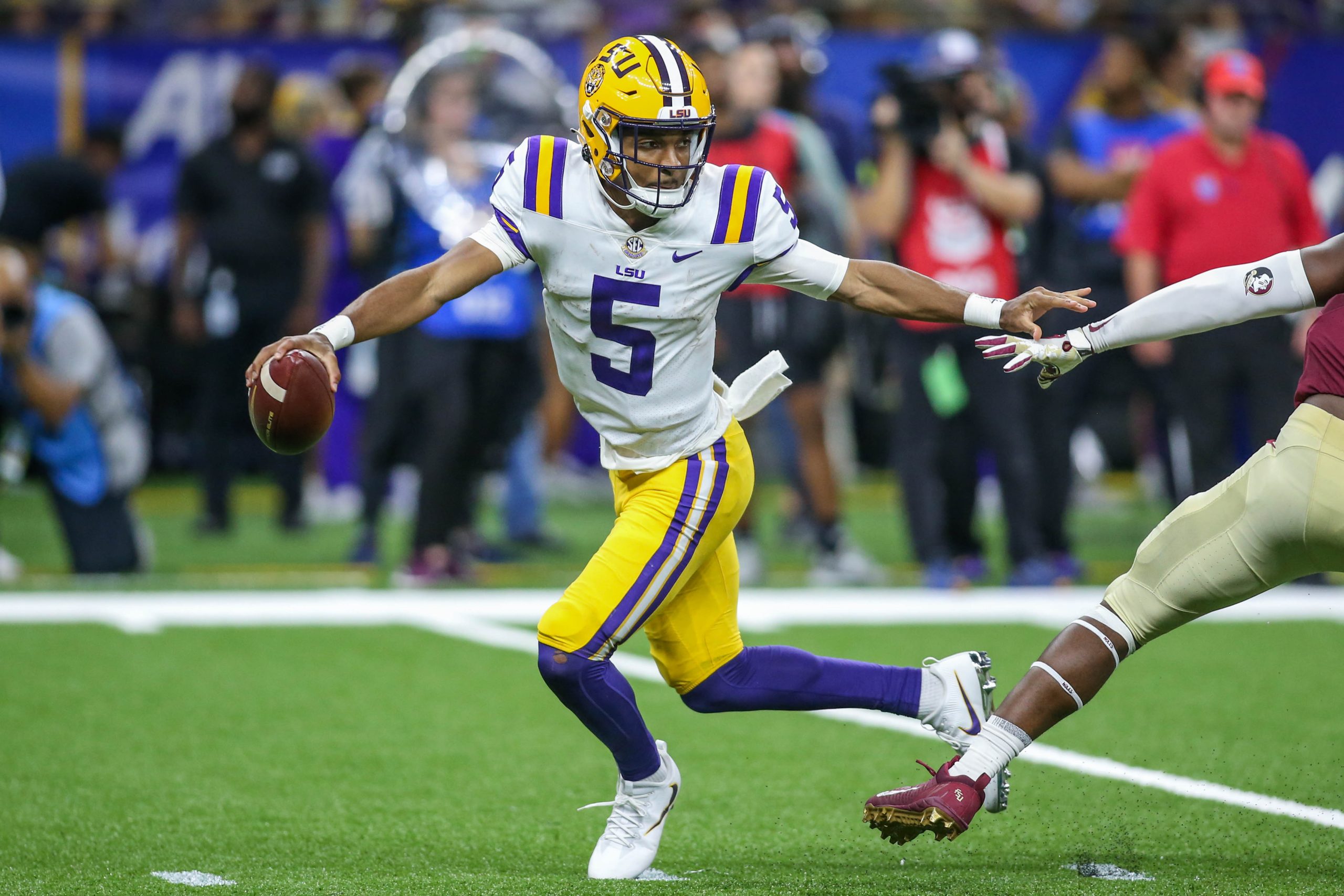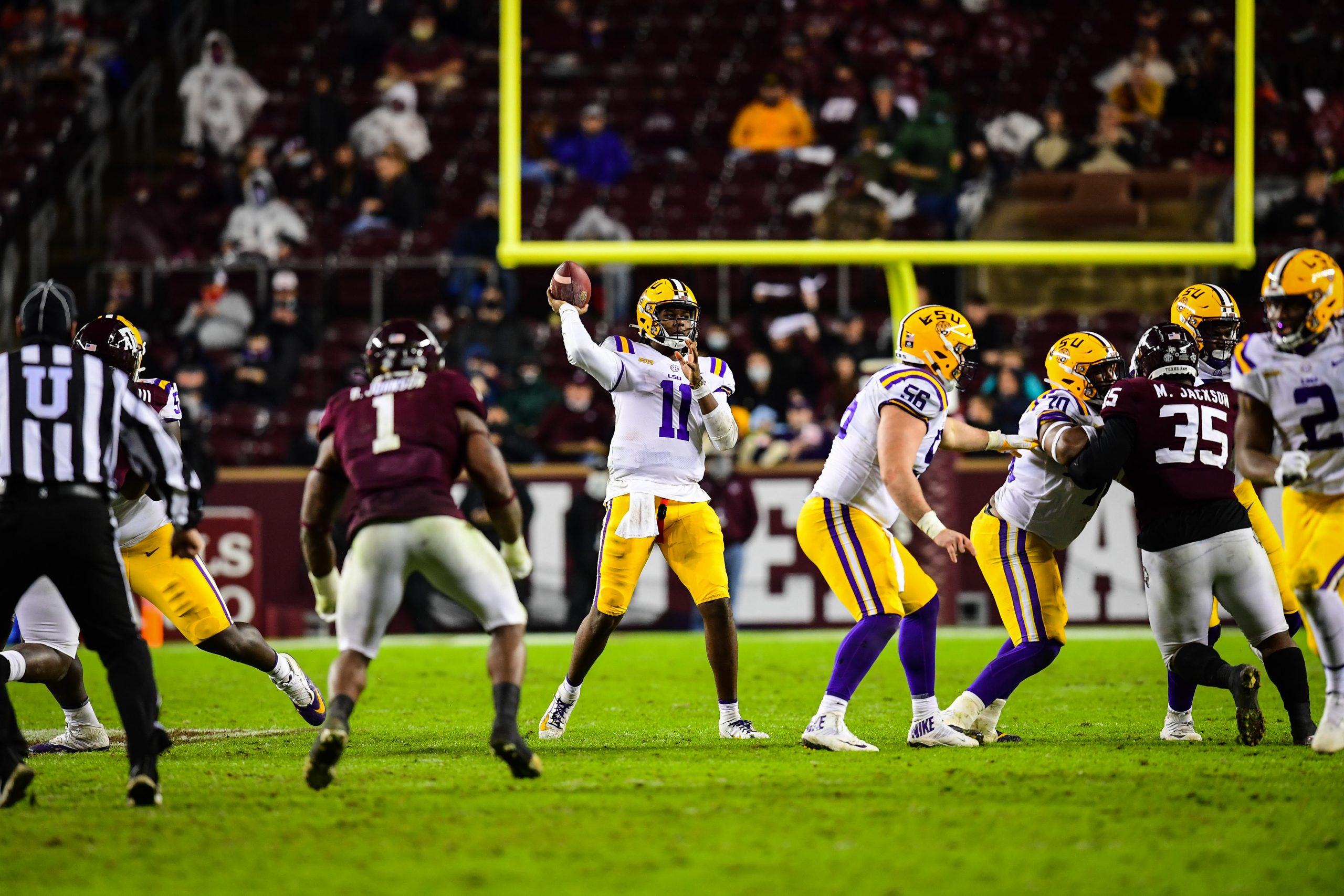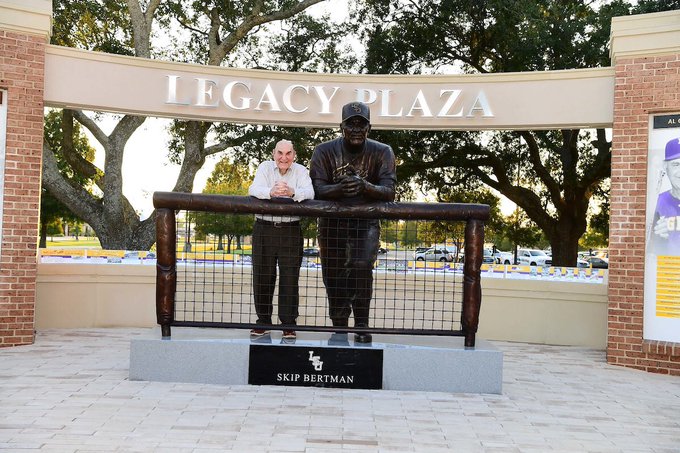
BATON ROUGE — If any Team of Troy should have cowardly tried to get out of a game with LSU as the current USC has for two years, it should have been the 1979 Trojans instead.
USC was coming off its fifth national championship since 1962 in 1978 at 12-1 in the coaches’ poll. (Alabama, strangely, won the Associated Press national title at 12-1, even though it lost convincingly to USC, 24-14, in Birmingham.)
But the Trojans and coach John Robinson came to Tiger Stadium anyway on Sept. 29, 1979, as the nation’s No. 1 team for a non-conference game – unnecessary for a perennial national championship contender – in one of the most feared away, sundown stadiums in the country, aka Death Valley, at night no less. And it wasn’t even televised.
Present day USC coach Lincoln Riley, who fled Oklahoma after the 2021 season partly to avoid joining the SEC, is not a national championship contender in any way this season coming off a disappointing 8-5 season and ranked No. 23 in the nation. The Trojans and No. 13 LSU (10-3 last year) kick off on Sunday, Sept. 1, at 6:30 p.m. central time on ABC in Las Vegas – just five hours from Los Angeles.
Riley and the USC powers that be either have studied what happened and nearly happened to USC 45 years ago this month before trying to get out of the LSU game, or they were just chicken.
Robinson and company, meanwhile, were man enough to enter the gates of hell, and that’s no exaggeration … until the skies opened up in the fourth quarter. As No. 20 LSU led the No. 1 Trojans that humid night in Baton Rouge 45 years ago, surely Robinson and his USC superiors were wondering why the hell they didn’t schedule Cal Poly that night.
Or perhaps when Robinson and his players found themselves trapped in their bus on arrival by a swarm of a thousand crazed LSU fans.
In the end, though, Robinson stared into the eye of LSU’s live Bengal Tiger, Mike IV at the time, and proceeded to pillage their village, eventually took one of their women, and then had the audacity to occupy LSU 40 years later.
On Sept. 29, 1979, Robinson’s Trojans ripped the heart out of the 11-point underdog Tigers in the final moments for a 17-12 win in front of an overflow crowd of 78,322 at Tiger Stadium in one of the loudest, most legendary games in LSU history.
“You couldn’t hear. I remember that,” Robinson, 84, said in 2019 in his LSU football office across Nicholson Drive from Tiger Stadium, where he was an offensive consultant under then-coach Ed Orgeron from 2019-21. Robinson and Orgeron became friends when Orgeron was a USC assistant and later head coach before coming to LSU.
“I can remember talking to one of my assistants on the sideline that night, and he couldn’t hear me,” Robinson said. “He’s standing right next to me! ‘DO THIS.’ And he says, ‘HUH?’
And the crowd kept getting louder and louder as LSU took a 12-3 lead in the third quarter on a 38-yard field goal by junior Don Barthel of Rayville. The Tigers had taken a 6-3 lead early in the second quarter on a 13-yard touchdown pass by senior quarterback Steve Ensminger of Baton Rouge to senior fullback LeRoid Jones of Baker, but a two-point try failed. A 32-yard Barthel field goal with 2:36 left before half put LSU up 9-3.
The Tigers still led 12-3 in the opening minutes of the fourth quarter as the volume steadily grew.
“It was so loud,” Ensminger, who was LSU’s offensive coordinator from 2018-20, said. “Our tackles were not more than four feet away from me, and they couldn’t hear the signals. They kept watching the snap out of the corner of their eye. Our fans just kept hollerin’ as loud as they could.”
USC’s Heisman Trophy to-be backfield of senior tailback Charles White, who would win the award less than three months later, and sophomore fullback Marcus Allen, who would win it in 1981, gained 185 yards on 31 carries and 48 on nine carries, respectively.
They ran behind “a wall of monsters,” as LSU senior defensive end John Adams of DeRidder described it. Six of USC’s offensive linemen that year — tackles Anthony Munoz, Don Mosebar and Keith Van Horne, guards Brad Budde and Roy Foster and center Bruce Matthews — were drafted in the first round as were backs White and Allen.
In all, from USC’s monstrous 1979 roster, 33 players were selected in the NFL Draft from 1980 through 1984, including 12 in the first round. In addition to the eight above, also going in the first round were safety Ronnie Lott, safety Dennis Smith, linebacker Chip Banks and safety Joey Browner. Four from that roster reached the Pro Football Hall of Fame – Allen, Lott, Matthews and Munoz.
But the NFL Combine, known as USC, had nothing to show for all that talent through three quarters and change except for a 32-yard field goal by Eric Hipp for a 3-0 lead late in the first quarter over LSU, which had just 16 players drafted in all from their 1979 roster and none in the first round.
“You damn right I was worried in the fourth quarter,” Robinson said. “We couldn’t get a lot going. We struggled just to function.”
A Memorable Greeting
The Trojans also struggled to get out of the bus the Friday night before the game for a practice in Tiger Stadium.
LSU held a raucous pep rally on the Parade Grounds with the Golden Band from Tigerland, cheerleaders and players that was something out of “Everybody’s All-American,” eight years before it was filmed at LSU.
“I haven’t seen a pep rally like this for about 20 years, and it happened right on this spot,” then-LSU athletic director Paul Dietzel told the crowd.
Dietzel had coached the Tigers to the national championship in 1958 and to the famous 7-3 win over Ole Miss behind Billy Cannon’s iconic punt return in a No. 1 vs. No. 3 Game of the Century in Tiger Stadium on Oct. 31, 1959, after said pep rally.
“Let’s beat the hell out of them,” Dietzel yelled.
Shreveport senior quarterback David Woodley, who shared time with Ensminger before directing the Miami Dolphins to Super Bowl XVII in the 1982 season, took the microphone.
“I don’t think they’re going to score a point on our defense,” he said as the crowd went wild again.
But this bayou bacchanalia was only just beginning.
As LSU coach Charles McClendon, who had already been forced to resign with 1979 designated as his last season, approached the podium, he was joined by a belly dancer someone ordered via the Merry Minstrel belly gram service. McClendon was more prepared for USC’s offense.
“No matter what happens. You’re going to be proud of your football team,” he said.
“Then near the end of the pep rally when everyone was worked into a frenzy, somebody ran on stage and took the microphone,” remembers Southeastern Conference associate commissioner Herb Vincent, then a freshman at LSU.
“He yelled, ‘USC is on the way to the stadium! C’mon, let’s go meet ’em,'” Vincent said. “It was like a scene out of some old college football movie. We all marched across campus to the stadium, where the USC buses were pulling up for practice.”
This was more than a meet and greet, though. This was closer to the ‘Let’s do it! Go. Go. Go,’ speech from John Belushi in the “Animal House” blockbuster that had just come out the previous year. This was a siege to be exact.
“They wouldn’t let us off the bus,” Robinson said. “There were about 2,000 students. They were rockin’ the bus. I didn’t expect that. That didn’t happen when we played Oregon or Notre Dame. Eventually, they got the police, and we got out of there.”
But the mob was not done.
“We lined up in two rows to create a walkway for the team to get in the stadium,” said Vincent, who days later would start work as a student assistant in LSU’s sports information department and become its director a decade later.
“We were all yelling, ‘Tiger Bait! Tiger Bait!’ The players looked shell-shocked when they walked off the bus,” Vincent said. “There was no pushing or shoving, no cursing or taunting. Just several hundred LSU students in their face screaming, ‘Tiger Bait!'”
Then USC was allowed to practice.
“After they were in the stadium, we felt like we had sufficiently terrorized our opponent,” Vincent said.
‘Man, What About That Tiger?’
Come Saturday night, the Tigers, about 78,322 fans, and one live Bengal Tiger kept the terror going.
Trooper’s 1978 hit “Raise a Little Hell” fittingly blared from a dormitory window inside Tiger Stadium at 9 a.m. Saturday — more than 10 hours from the 7:30 p.m. kickoff. Yes, at the time, students literally lived the stadium. The party had been raging since the previous Wednesday as students living near or in the stadium were told to not park for the rest of the week in their usual spots.
The Winnebagos were coming. Tailgating was getting an early start. And USC was on the menu.
“All I remember is the fans and that Tiger,” Charles White told me at the Alexandria Town Talk in 1989 for a 10-year anniversary piece on the game. “We could hear him growling when we were in the locker room. It was scary.” (White passed away in 2023.)
At the time, LSU would put Mike IV in its wagon cage on game nights and park him just inside the portal of the southeast corner next to the visitor locker room.
“He was right there when we came out on the field,” White said. “It was amusing to me to view something that you normally only see on wildlife TV shows. And then, all of a sudden, he’s right there in your face.”
Mike IV’s handlers had “creative ways to get him to roar,” said Rick Perry, a student at LSU in 1979 who later worked in the athletic department for decades before becoming president of the Tiger Athletic Foundation.
“That tiger was right next to us,” Robinson said. “I can remember looking right at him and somebody poking him in the butt. They don’t do that anymore. Too bad.”
USC’s captive bus ride and visit to the Big Cat portion of the LSU Zoo would soon end, and it was time to play.
“I think some of them were really scared when Mike was roaring,” LSU senior center John Ed Bradley of Opelousas said in 1989. Bradley went on to become a national sportswriter star at the Washington Post and Sports Illustrated and author of several books.
“And they were stunned by the crowd when they first went on the field,” he said. “I don’t think USC’s players knew what the hell was going on. And they came out back on their haunches.”
After a hearty collision on the first play of the game, a USC defensive lineman came up to Bradley. But not to trash talk.
“He said, ‘Man, what about that Tiger?’” Bradley said.
USC Comes Back
USC eventually regrouped in the fourth quarter for a 57-yard drive in six plays with White scoring on a 4-yard run with 9:54 to play to cut LSU’s lead to 12-10.
The Tigers were apparently about to hold on and shock the world when senior defensive tackle Demetri Williams of Plaquemine sacked USC quarterback Paul McDonald, a fourth-round pick, on third-and-nine from the USC 36 with under four minutes to play.
But junior defensive tackle Benjy Thibodeaux of Rayne grazed McDonald’s face mask on the play, and the flag flew. Had incidental face masking been called, LSU would have been penalized only five yards with USC still facing a fourth-and-four from its 40. But the lesser, incidental face mask penalty did not arrive until 1982, so LSU was penalized 15 yards. This gave the Trojans a first down at the Tigers’ 49. After six plays, McDonald found wide receiver Kevin Williams for an 8-yard touchdown and a 17-12 lead with 32 seconds to go.
“It was a clench. I got a piece of it,” Thibodeaux said in 1989. “And dammit, I hate to say that. The face masking is something that’s been chasing me for 10 years. One damn play. It still hurts.”
It was still hurting LSU fan Beverly Williams that day in 2009 when John Robinson walked into a bank in Los Angeles. He was retired at the time after stints at USC from 1976-82 and 1993-97, the Los Angeles Rams from 1983-91 and UNLV from 1999-2004.
“This woman comes up to me and says, ‘I have a client in my office who’s a USC person and would like to meet you,'” Robinson said. “I didn’t give a damn about the client and started talking to her instead, because this is a good-looking woman. I’m divorced. I found out later she was, too.”
Robinson’s game plan initially stalled.
“Where’d you go to school?” he said.
“I went to LSU,” she said.
“Oh, we played LSU,” he said.
Not a good call by Robinson.
“I know,” she said. “I was there. And you cheated to win the game.”
But he still got the girl. They’ve been married for 14 years.
“I was shocked that 30 years later this woman remembered that in detail,” he said. “And she’s still pissed.”
Welcome to the LSU Nation, Mr. Robinson!
Beverly, who was a financial planner at that bank, and John began taking trips to New Orleans to see her mother. Then they moved to Baton Rouge with Robinson switching sides.
“Whenever she gets mad at me, she says, ‘You cheated against LSU,'” he said. “She loves the South. She loves New Orleans. She loves LSU, and she’s outspoken about it.”
So Close, Yet So Far
The loss would bother McClendon more than any other, including all those to Alabama, which as the No. 1 team would beat LSU, 3-0, later in the 1979 season in Tiger Stadium.
“The USC game, it’ll go with me to my grave,” McClendon said in 1993. He passed away in 2001.
“I don’t think there’s any question about it,” McClendon said. “If we had gotten that game under our belts, we could have finished undefeated. No one could have touched us.”
Instead, LSU dropped to 2-1 with the loss and would lose three other close ones in addition to Alabama – 21-14 at Georgia, 24-19 at No. 8 Florida State, and 24-13 at No. 18 Tulane – before beating Wake Forest in the Tangerine Bowl to finish 7-5. USC went on to finish 11-0-1 with its only blemish a 21-21 tie with Stanford. Alabama won the national championship at 12-0, but the College Football Researcher Association later awarded a national title to USC.
LSU did come close to pulling out the USC game in the final seconds after the Trojans went up 17-12. Following a 15-yard penalty against USC after the kickoff return, LSU took over on its 42-yard line. On second down, Ensminger hit junior tight end Robert DeLee of Clinton for 28 yards to the USC 30.
With eight seconds left, Ensminger spotted an open Willie Turner, a sophomore wide receiver from New Orleans, behind the defense and let it fly.
“The whole stadium breathed in at the same time,” said Baton Rouge attorney James Manasseh, son of LSU’s sports information director that night – Paul Manasseh. James was an LSU student working the game in the press box, where he has done the play-by-play since 1982.
“It really looked like he might catch it,” Manasseh said.
“I thought I got pushed,” Turner said after the game. “I couldn’t have run the route any better. It was just a matter of getting my fingers on the ball. I had it on my fingertips.”
But he didn’t hold on in the end zone.
“I’m telling you, when he went up for that pass, you could hear the gasp of the entire stadium,” Manasseh said.
Two seconds still remained. Ensminger threw for senior wide receiver Carlos Carson in the end zone, but it was broken up.
“I threw two balls in the end zone that had a chance of being caught,” Ensminger said.
‘USC Shall Always Remember Tiger Stadium’
Another throng of LSU students later that week watched the game in the Pub restaurant and bar below the Hodges dorm on tape delay via a new sports network that had dawned just three weeks before on Sept. 7, 1979. It was called ESPN – the Entertainment and Sports Network. The still fuming LSU students threw food and drink at the Pub screen after the flag flew against Thibodeaux.
Amazingly, the game was not televised live because USC would have surpassed the NCAA limit of five televised games on ABC in two seasons. USC was on three times in 1978 and already had national TV games set for 1979 against UCLA and Notre Dame.
Instead, ABC nationally televised No. 14 Ohio State at No. 17 UCLA in the afternoon before the LSU-USC game and regionally televised USL and Arkansas State from Jonesboro, Arkansas, at 11:50 a.m.
“It’s amazing it was not televised,” Manasseh said. “Of all the LSU games, even though LSU lost, it remains one of the greatest games ever in that stadium.”
Even though the stadium was about 24,000 fans below its current capacity of 102,321, Tiger Stadium on that Saturday night, Sept. 29, 1979, remains known as the loudest LSU home game ever — based on sustained volume.
“Yes,” Perry said. “Because it was continuous. Other games since then and recently have been louder for periods of time, but that night, it never really seemed to cease for the whole game. And in the student section, nobody sat down the entire game. That has never happened before or since. There was this deafening, constant roar for the entire game. It never stopped. Then it gradually grew in the fourth quarter when we were up 12-3.”
And after the loss, LSU received a standing ovation from its fans, who remained in their seats long afterwards. That also rarely, if ever, happens after a loss.
Budde, the USC All-American guard, uttered a quote used in LSU’s media guides virtually every year since.
“Unbelievable. Crazy. That place makes Notre Dame sound like Romper Room,” he said, referencing the syndicated show for toddlers.
Robinson still calls it one of the loudest places in which he has coached.
“I always told the team, ‘They’ll be cheering when the game starts, and by the middle of the first quarter, they will all have gotten tired of cheering. And it will settle down, or you will get used to it,'” he said. “Well, that wasn’t true on that night. I sold all that to them, but it was all BS. Because you just couldn’t hear, and you never could.”
And 40 years later, Robinson knows he escaped luckily into the night. Or that’s what he tells his wife, at least.
“They thought they had the game, and probably deserved the game,” he said. “And all of a sudden, it’s gone. So, you just shake your head.”
And the game remains in the heads of all those helmets on both sides.
“I am proud of our team. We left our guts out on the football field,” Bradley wrote in a game-week daily diary published in the Baton Rouge Advocate beginning the Monday following the game. “I think USC shall always remember Tiger Stadium.”
Robinson agrees.
“Players from that team still remember it,” he said. “Guys have called or come by, and said, ‘Hey coach, remember when we went down to LSU. Remember that Tiger?'”
It was the night Tiger Stadium roared like no other.
LSU did exact some revenge against USC in the rematch exactly five years later on Sept. 29, 1984, at the Coliseum in Los Angeles. The Tigers and new coach Bill Arnsparger embarrassed the No. 15 Trojans and second-year coach Ted Tollner, 23-3. Robinson had left after the ’82 season to become coach of the Los Angeles Rams.
Maybe, USC’s powers knew what was coming to open the 2024 season. Can you blame them for trying to get away from LSU?




Be the first to comment